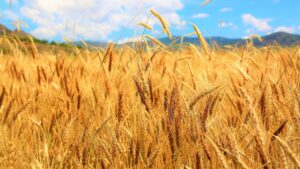A global effort is underway to lower the cost of hybrid wheat seed production.
Each year, Australian wheat growers plant one of the world’s largest wheat crops (China, India and Russia plant the world’s most extensive wheat acreage). In terms of total production, Australia produces the tenth-largest crop of wheat. Whether or not hybrid wheat can boost Australian wheat yields and raise its position among wheat-producing countries will depend on several significant developments. Ryan Whitford, PhD, a plant molecular biologist at the hybrid wheat program at the Australian Centre of Plant Functional Genomics, explained to Seed World why hybrid wheat has been slow to be adopted in one of the world’s largest wheat-growing regions.
“I don’t think my Australian perspective about hybrid wheat is different from someone in the United States,” he says. “Australia’s low-yield growing environment is different than growing conditions in North America and Europe. That makes the economics behind the commercialization of hybrid wheat a little more challenging for us. For that to happen, the economics have to shift a bit. This is not to say hybrid wheat will not come on in the future. Currently, however, there is not much appetite for it.”
New technologies are lowering the cost of hybrid seed production. This may open that opportunity. Interest in hybrid wheat would be mostly restricted to Australia’s higher-yielding zones where hybrid seed could overcome some of these environmental and economic barriers. Hybrid wheat seed will come at a premium, whether planted in a high or low yield environment.
“In our low yield environments where low moisture limits production, the average yield is just below 30 bu. per acre (2 tons per hectare). In this scenario, hybrid wheat gets about an 8% yield boost or about 2.5 bu. per acre, advantage from breeding. Economically, that is not good enough. We would need to get a hybrid yield advantage of 10% or more to overcome the added cost of hybrid seed production.”
In high yield environments with more rainfall, wheat yields 45 to 60 bushels bu. per acre or more. Compare this to European production where it is a different scenario. Hybrid wheat is more economical in the high-yield regions.
Improved Yield Stability
One feather of hybrid wheat is that it provides better yield stability in more challenging environments with there are widely varying growing conditions within a field. Nonetheless, the field’s overall hybrid yield advantage has to be enough to make the premium seed cost economically feasible. Another issue for Australian growers is that they are assessed end-point royalties where breeder royalties are paid at the back end of production when the crop is delivered to market. Farmers may be reticent to pay for hybrid wheat upfront because there is no guarantee that they will get a yield advantage.
If there is a drought event, it can knock the crop over, Whitford says. In that situation, farmers are better off paying an end-point royalty rather than with the up-front seed cost. There are multiple facets to their decision as they consider whether or not to purchase hybrid wheat. Traditionally, they are used to planting farm-saved seed year after year.
“This is not to say that I think hybrid wheat will never happen in Australia. I think it will. For that to happen, the economics have to shift a bit,” Whitford says. “The economic improvement will depend on research and development from research centers such as the Australian Centre of Plant Functional Genomics where I work. We are involved globally with major institutions and multinational companies. Our work focuses on lowering the high cost of hybrid wheat breeding. Some researchers are working on cytoplasmic male sterility (CMS). That is one of the new technologies that will allow us to produce hybrid wheat seed in a more economical fashion. With new marker technologies, breeders are able to reduce the cost and make hybrid production easier. It is still challenging because it requires crossing on a large scale. It is improved pollination control technologies that enable breeders to use the new marker technologies.” Whitford sees considerable global efforts being made to use genetic resources, such as sequencing the wheat genome.
A Global Effort for Hybrid Wheat
There are breeders and molecular geneticists with particular skill sets all around the world. Companies in the United States and Europe are now looking to Australia because Australia had a hybrid wheat breeding program some years ago.
According to Whitford, some of those wheat genetics were quite well developed. Now companies want to tap into knowledge by adding to the skillset of their research scientists who are looking into pollination control technologies. The extent of individual collaborations depends on the skillsets involved and the politics behind it. Active global collaborators include CIMMYT in Mexico, the University of Nebraska and a few institutions in Europe as well the Australian Centre of Plant Functional Genomics. There is also renewed commercial activity, but it is generally surrounded by layers of confidentially. There is a bit of a race going on. There are global efforts.
“The added yield benefits of hybrid wheat are likely to be realized as new breeding technologies capable of lowering the cost of hybrid seed production are adopted over the next 10 years. I think we will see hybrids come on that are capable of reducing the cost of hybrid seed production. As more money is invested in the technologies behind it, we will get broader deployment of hybrids. I would really like to see hybrid wheat come on. Hybrids are a nice value capture system for other traits, whether that be genome-edited traits or GM traits for drought tolerance or nitrogen use efficiency,” Whitford says.
From a seed genetics company’s point of view, another facet that sits behind hybrid wheat is competition from farm-saved, brown-bag seed. Hybrid seed is a way of making sure that breeders’ proprietary traits are protected. Ultimately, plant breeding is a numbers game. Yield gain is what the race is about. One of the best technologies for achieving higher wheat yields is hybrid breeding.













